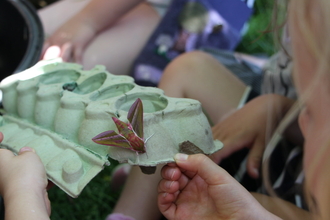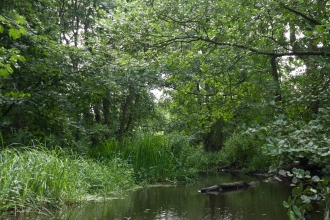Wet Willow Wildlife
Wet Willow Wildlife is our Species Survival Fund project enhancing wet willow habitats at landscape scale to support a multitude of species, including bees, moths, amphibians, mammals, plants, birds and more.
The project will play a vital role in protecting the willow tit, a bird species currently under threat with numbers of breeding pairs dwindling.
Working in Greater Manchester and Mersey Gateway with partners The Conservation Volunteers, we will create new nature networks and provide opportunities for people to get involved through Citizen Science, community events and practical conservation activities.

Willow tit. Photo by Harry Hogg
More than 15 per cent of the UK’s willow tits are found in the North West, with Wigan being a central point with the network radiating out along river valleys. LWT and TCV will work with landowners/stakeholders like the Woodland Trust, Trafford Council and Mersey Gateway Environment Trust, as well as partners in the Great Manchester Wetlands.
Willow tits are black, pale brown and white in colour. They have a pale panel on the wings and a sooty-black cap and bib. Theirs is a distinctive, nasal “zee, zee, zee” call, which is often the most reliable way to identify the bird.
The Wet Willow Wildlife project aims to boost the willow tit’s chances of survival but has many benefits for people getting involved in surveying and volunteering.
LWT Head of Landscape Nature Recovery Jo Kennedy said: “The Lancashire Wildlife Trust is delighted to be involved with this Species Survival Fund project which will make a major difference to the survival of multiple species that rely on wet willow woodland habitat, including the threatened willow tit.

Willow tit feeding it's young.
Photo by Peter Smith
Habitat creation, enhancement and restoration
We are improving wet willow habitats across around 27 sites in Trafford, Mersey Gateway, Salford, Wigan and Bolton, identified as having high potential to boost wet willow species.
Habitat connectivity
By strategically creating and improving habitat pockets connected by linking habitats, we are enhancing connectivity for wet willow species, allowing for greater movement and dispersal over a wide geographic area.
Community engagement
We are involving people in the project through citizen science surveying, habitat conservation opportunities, partnerships with local groups and a variety of community events to raise awareness and help involve local communities in their local nature.
Species conservation
The project aims to benefit a range of species, including the red-listed Willow Tit, which is Britain’s fastest declining resident bird. Willow Tit numbers have dropped by more than 90 per cent in just over half a century – in their Greater Manchester stronghold breeding pairs have decreased from 300 in 1984 to around 120 according to estimates.
By providing suitable habitat and enhancing connectivity, the project contributes to the survival and recovery of threatened species.
Capacity building
We are providing opportunities for skills development and capacity building through practical conservation activities, volunteer programmes and training initiatives, empowering local communities to actively participate in nature recovery.
“We want to demonstrate the importance of the messy woodland on which willow tit and other special species rely," Matt McMullen, Senior Nature Recovery Officer at LWT.


Willow tit at Pennington Flash. Photo by Peter Smith
Project funders and timescales
The Wet Willow Wildlife project has funding from the Government's Species Survival Fund. The fund was developed by Defra and its “Arm’s-length bodies”. It is being delivered by The National Lottery Heritage Fund in partnership with Natural England and the Environment Agency.
The project runs until February 2026 and will leave in place long-term plans for the continued management of improved sites. Through the project, we hope to identify areas of further opportunity to bring together a North-West-wide wet willow network.
Projects for Nature are bringing together a unique collaboration of businesses, eNGOs, expert environmental bodies and government to achieve one goal: bring Projects for Nature to life to bridge the funding gap and accelerate urgently needed nature recovery. We are delighted to have been accepted onto the Projects for Nature project portfolio. WE have till the end of March 2025 to raise funds to secure the survival of Bolton's Willow Tits.
Habitats and Species
Wet willow woodlands are damp, scrubby, somewhat untidy areas made up of tree species that thrive in wet, waterlogged or seasonally-flooded soils, including various species of willow, birch and alder. The group of species in wet woodland can vary from place to place; willow trees particularly thrive in the wet woodlands across our region, which is why we refer to these areas as wet willow habitat.
Willow Tit in our region – which is somewhat of a hotspot for the species – make their homes in wet willow woodland with scrubby bramble, nettle and hawthorn. They love woodland that many people would see as scruffy, with impenetrable brambles, rotting wood and wet ground. These damp areas provide the conditions for Willow Tit to dig nest holes, which they do every year, and find their food. Making space for this unruly habitat is important to their survival and thriving in the region.
It is crucial that their territories are connected. The undervalued habitat on which they rely can be lost too and become broken up through development, and if left can become too mature. If there are too many mature broadleaved trees other species such as blue tit and woodpeckers can move in and outcompete or predate Willow Tit.
Other species like Poplar Hawk Moth, Small Sallow Mining bee (Andrena praecox) and Lesser Redpoll also associate with this habitat and will benefit. This type of woodland supports a further range of wildlife, including invertebrates (including Hymenoptera species), bats, amphibians, mammals and of course plants including helleborines, mosses, lichens and ferns. Willow itself plays an important role in the ecosystem. For instance, almost exclusively providing spring emergent queen bumblebees with their first pollen feed of the year.
Our work on the project will build on previous Great Manchester Wetlands partners’ approaches to willow tit conservation in Wigan and Trafford and through Citizen Science approaches.
Get involved

Willow tit. Photo by Ed Marshall
- Fancy surveying for the diminuntive willow tit? Or bashing some invasive Himalayan balsam? Perhaps learning about the habitat requirements of wet willow species and putting new practical skills into practice? See here for details of volunteering opportunities.
- To participate in our upcoming citizen science program, and join a local moth survey group, please apply to become a survey volunteer - New Moss Wood / Mersey Gateway
- Or keep an eye out for our exciting programme of events that anyone can join in with.
- We are also keen to hear from landowners who might have suitable sites for future projects.
What have we been up to

Spring forward into nature: Connect, conserve, and get involved
Find out what our Wet Willow Wildlife project team have been up to; moth trapping, tree planting and even school children pretending to…
Tiny birds, big mission: Volunteers gear up for willow tit surveys
Wet Willow Wildlife is our Species Survival Fund project enhancing wet willow habitats at landscape scale to support a multitude of…
Citizen Science – Become a willow tit survey volunteer
Wet Willow Wildlife is our Species Survival Fund project enhancing wet willow habitats at landscape scale to support a multitude of…




